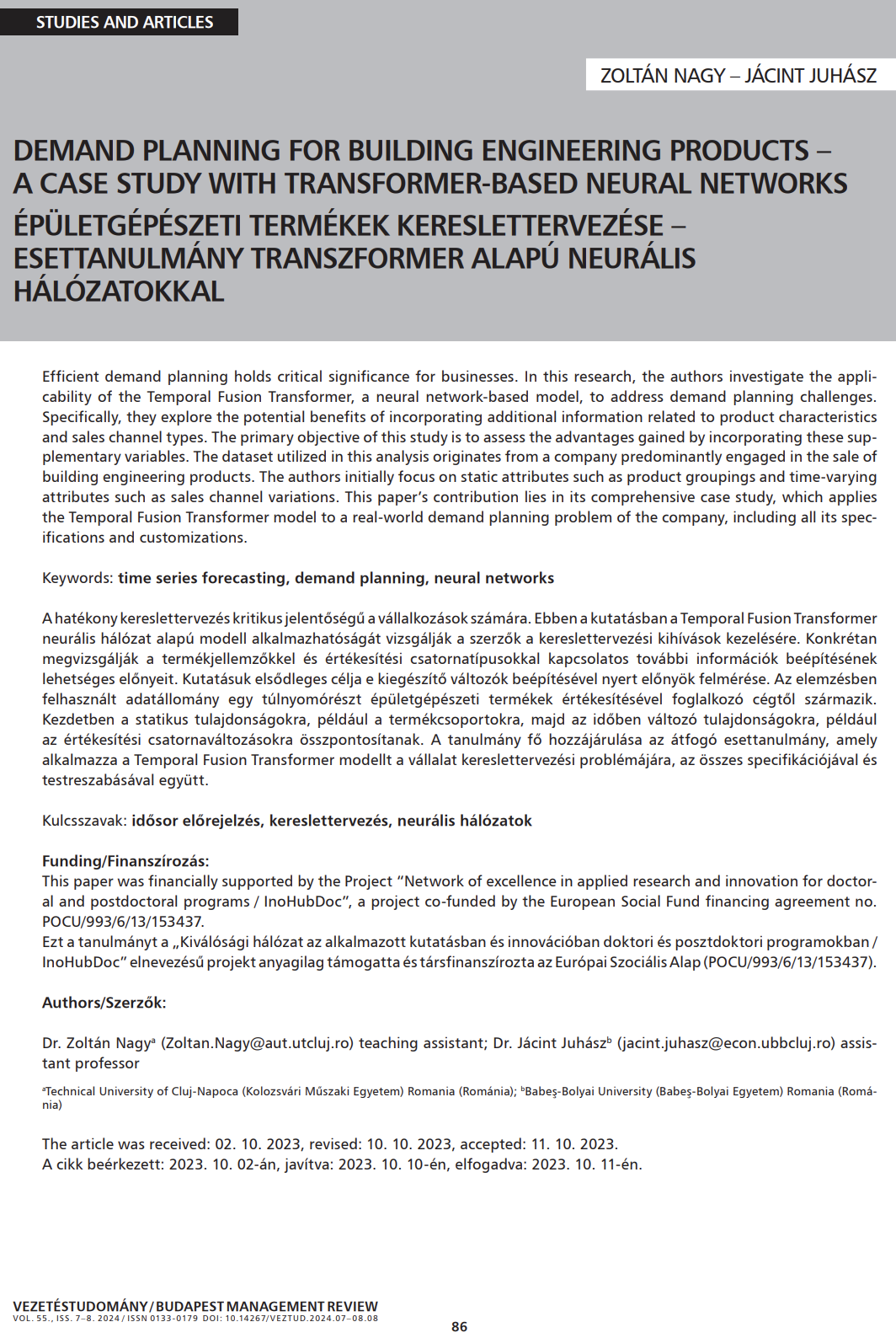Demand planning for building engineering products
A case study with transformer-based neural networks
DOI:
https://doi.org/10.14267/VEZTUD.2024.07-08.08Keywords:
time series forecasting, demand planning, neural networksAbstract
Efficient demand planning holds critical significance for businesses. In this research, the authors investigate the applicability of the Temporal Fusion Transformer, a neural network-based model, to address demand planning challenges. Specifically, they explore the potential benefits of incorporating additional information related to product characteristics and sales channel types. The primary objective of this study is to assess the advantages gained by incorporating these supplementary variables. The dataset utilized in this analysis originates from a company predominantly engaged in the sale of building engineering products. The authors initially focus on static attributes such as product groupings and time-varying attributes such as sales channel variations. This paper’s contribution lies in its comprehensive case study, which applies the Temporal Fusion Transformer model to a real-world demand planning problem of the company, including all its specifications and customizations.
Downloads
References
Akiba, T., Sano, S., Yanase, T., Ohta, T., & Koyama, M. (2019). Optuna: A next-generation hyperparameter optimization framework. Proceedings of the 25th ACM SIGKDD International Conference on Knowledge Discovery & Data Mining, 2623–2631. https://doi.org/10.1145/3292500.3330701
Altan, A., & Karasu, S. (2022). Crude oil time series prediction model based on LSTM network with chaotic Henry gas solubility optimization. Energy, 242, 122964. https://doi.org/10.1016/j.energy.2021.122964
Anderson, O.D. (1977). The Box-Jenkins approach to time series analysis. RAIRO-Operations Research, 11(1), 3–29. https://doi.org/10.1051/ro/1977110100031
Barros, J., Cortez, P., & Carvalho, M.S. (2021). A systematic literature review about dimensioning safety stock under uncertainties and risks in the procurement process. Operations Research Perspectives, 8, 100192. https://doi.org/10.1016/j.orp.2021.100192
Bashir, F., & Wei, H.L. (2018). Handling missing data in multivariate time series using a vector autoregressive model-imputation (VAR-IM) algorithm. Neurocomputing, 276, 23–30. https://doi.org/10.1016/j.neucom.2017.03.097
Challu, C., Olivares, K.G., Oreshkin, B.N., Ramirez, F.G., Mergenthaler-Canseco, M., & Dubrawski, A. (2023). NHITS: Neural Hierarchical Interpolation for Time Series Forecasting. Proceedings of the 37th AAAI Conference on Artificial Intelligence, AAAI 2023, 37. https://doi.org/10.1609/aaai.v37i6.25854
Chatfield, C. (1978). The Holt-winters forecasting procedure. Journal of the Royal Statistical Society: Series C (Applied Statistics), 27(3), 264–279. https://doi.org/10.2307/2347162
Chimmula, V.K.R., & Zhang, L. (2020). Time series forecasting of COVID-19 transmission in Canada using LSTM networks. Chaos, Solitons and Fractals, 135, 109864. https://doi.org/10.1016/j.chaos.2020.109864
Deloof, M. (2003). Does working capital management affect profitability of Belgian firms? Journal of Business Finance and Accounting, 30(3–4), 573-588. https://doi.org/10.1111/1468-5957.00008
El Bourakadi, D., Ramadan, H., Yahyaouy, A., & Boumhidi, J. (2023). A robust energy management approach in two-steps ahead using deep learning BiLSTM prediction model and type-2 fuzzy decision-making controller. Fuzzy Optimization and Decision Making, 22, 645-667. https://doi.org/10.1007/s10700-022-09406-y
Garcia, J.L., Martins, F.V., & Brandão, E. (2012). The Impact of Working Capital Management Upon Companies’ Profitability: Evidence from European Companies. SSRN Electronic Journal. https://doi.org/10.2139/ssrn.2165210
Gardner Jr, E.S. (1985). Exponential smoothing: The state of the art. Journal of Forecasting, 4(1), 1–28. https://doi.org/10.1002/for.3980040103
Hastie, T., & Tibshirani, R. (1987). Generalized additive models: some applications. Journal of the American Statistical Association, 82(398), 371–386. https://doi.org/10.2307/2289439
Hipel, K.W., McLeod, A.I., & Lennox, W.C. (1977). Advances in Box-Jenkins modeling: 1. Model construction. Water Resources Research, 13(3), 567–575. https://doi.org/10.1029/WR013i003p00567
Hong, T., & Wang, P. (2014). Fuzzy interaction regression for short term load forecasting. Fuzzy Optimization and Decision Making, 13, 91–103. https://doi.org/10.1007/s10700-013-9166-9
Janakiraman, G., & Roundy, R.O. (2004). Lost-sales problems with stochastic lead times: Convexity results for base-stock policies. Operations Research, 52(5), 795– 803. https://doi.org/10.1287/opre.1040.0130
Jeffery, M.M., Butler, R.J., & Malone, L.C. (2008). Determining a cost-effective customer service level. Supply Chain Management: An International Journal, 13(3), 225–232. https://doi.org/10.1108/13598540810871262
Koutsandreas, D., Spiliotis, E., Petropoulos, F., & Assimakopoulos, V. (2022). On the selection of forecasting accuracy measures. Journal of the Operational Research Society, 73(5), 937–954. https://doi.org/10.1080/01605682.2021.1892464
Lazaridis, I., & Tryfonidis, D. (2006). The relationship between working capital management and profitability of listed companies in the Athens Stock Exchange. Journal of Financial Management and Analysis, 30(76), 1-12. https://papers.ssrn.com/sol3/papers.cfm?abstract_id=931591
Lim, B., Ark, S.Ö., Loeff, N., & Pfister, T. (2021). Temporal fusion transformers for interpretable multi-horizon time series forecasting. International Journal of Forecasting, 37(4), 1748–1764. https://doi.org/10.1016/j.ijforecast.2021.03.012
Liu, A., Lu, J., & Zhang, G. (2020). Concept drift detection: dealing with missing values via fuzzy distance estimations. IEEE Transactions on Fuzzy Systems, 29(11), 3219–3233. https://doi.org/10.1109/TFUZZ.2020.3016040
Nguyen, H.D., Tran, K.P., Thomassey, S., & Hamad, M. (2021). Forecasting and Anomaly Detection approaches using LSTM and LSTM Autoencoder techniques with the applications in supply chain management. International Journal of Information Management, 57, 102282. https://doi.org/10.1016/j.ijinfomgt.2020.102282
Nobanee, H. (2017). Working Capital Management of Small Firms. SSRN Electronic Journal. https://doi.org/10.2139/ssrn.2970031
Oreshkin, B.N., Carpov, D., Chapados, N., & Bengio, Y. (2020). N-BEATS: Neural basis expansion analysis for interpretable time series forecasting. 8th International Conference on Learning Representations, ICLR 2020. https://openreview.net/attachment?id=r1ecqn4Yw-B&name=original_pdf
Salinas, D., Flunkert, V., Gasthaus, J., & Januschowski, T. (2020). DeepAR: Probabilistic forecasting with autoregressive recurrent networks. International Journal of Forecasting, 36(3), 1181–1191. https://doi.org/10.1016/J.IJFORECAST.2019.07.001
Shah, G., Fraser, J., Mandhana, V., & Verma, V. (2022). Working Capital Index Report 2022. https://www.jpmorgan.com/content/dam/jpm/treasury-services/documents/working-capital-report-2022.pdf
Taylor, S.J., & Letham, B. (2018). Forecasting at scale. The American Statistician, 72(1), 37–45. https://doi.org/10.1080/00031305.2017.1380080
Vaswani, A., Shazeer, N., Parmar, N., Uszkoreit, J., Jones, L., Gomez, A.N., Kaiser, Ł., & Polosukhin, I. (2017). Attention is all you need. Advances in Neural Information Processing Systems, 30. https://doi.org/10.48550/arXiv.1706.03762
Windaus, D., & Tebbett, S. (2021). Working Capital Report 2019/20: Creating value through working capital. https://www.pwc.com/gx/en/working-capital-management-services/assets/working-capital-report-final.pdf
Wu, B., Wang, L., & Zeng, Y.R. (2023). Interpretable tourism demand forecasting with temporal fusion transformers amid COVID-19. Applied Intelligence, 53(11), 14493–14514. https://doi.org/10.1007/s10489-022-04254-0

Downloads
Published
How to Cite
Issue
Section
License
Copyright (c) 2024 Corvinus University of Budapest, publisher of Vezetéstudomány / Budapest Management Review

This work is licensed under a Creative Commons Attribution 4.0 International License.
Authors assign copyright to Vezetéstudomány / Budapest Management Review. Authors are responsible for permission to reproduce copyright material from other sources.

